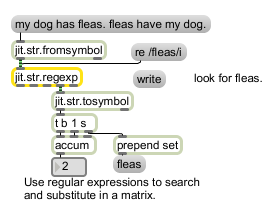Examples

Use PERL-compatible regular expressions on Jitter matrices
The jit.str.regexp object performs regular expression analysis to Jitter matrices, with optional substitution. To specify a regular expression, the re attribute is used. Substitutions may be specified with the substitute attribute. A full discussion of regular expressions is beyond the scope of this document, but you can read all about them here and here .
jit.str.regexp gets its regular expression know-how from the PCRE library package, which is open source software, written by Philip Hazel, and copyright by the University of Cambridge, England.
A word on Jitter strings: In Jitter, any 1 plane char matrix may be manipulated as a string. String matrices may have one or two dimensions. If 1-dimensional, the string is considered terminated at the first 0 (like in C). If 2-dimensional, the string may be considered a multi-line string, with the first 0 encountered on each row treated as a carriage return. The jit.textfile and jit.str.op objects will accept and output 2D matrices. jit.str.fromsymbol only outputs 1D matrices and jit.str.tosymbol only accepts 1D matrices (or the first row of a 2D matrix).
| Name | IOProc | Planelink | Typelink | Dimlink | Plane | Dim | Type |
| out | n/a | 1 | 1 | 1 | 1 | 1 | char |
| out2 | n/a | 1 | 1 | 1 | 1 | 1 | char |
| out3 | n/a | 1 | 1 | 1 | 1 | 1 | char |
| out4 | n/a | 1 | 1 | 1 | 1 | 1 | char |
| Name | Type | g/s | Description |
|---|---|---|---|
| descriptor | int | Output descriptor matrix flag (default = 0) | |
| re | symbol | The PERL-compatible regular expression to be used by jit.str.regexp for analysis of the incoming matrix. | |
| substitute | symbol | A substitution string. |

| Name | Description |
|---|---|
| jit.op | Apply binary or unary operators |
| jit.str.fromsymbol | Convert Max symbol to Jitter string matrix |
| jit.str.tosymbol | Convert Jitter string matrix to Max symbol |
| jit.textfile | Read and write a matrix as an ASCII text file |
| regexp | Use PERL-style regular expressions to process input |